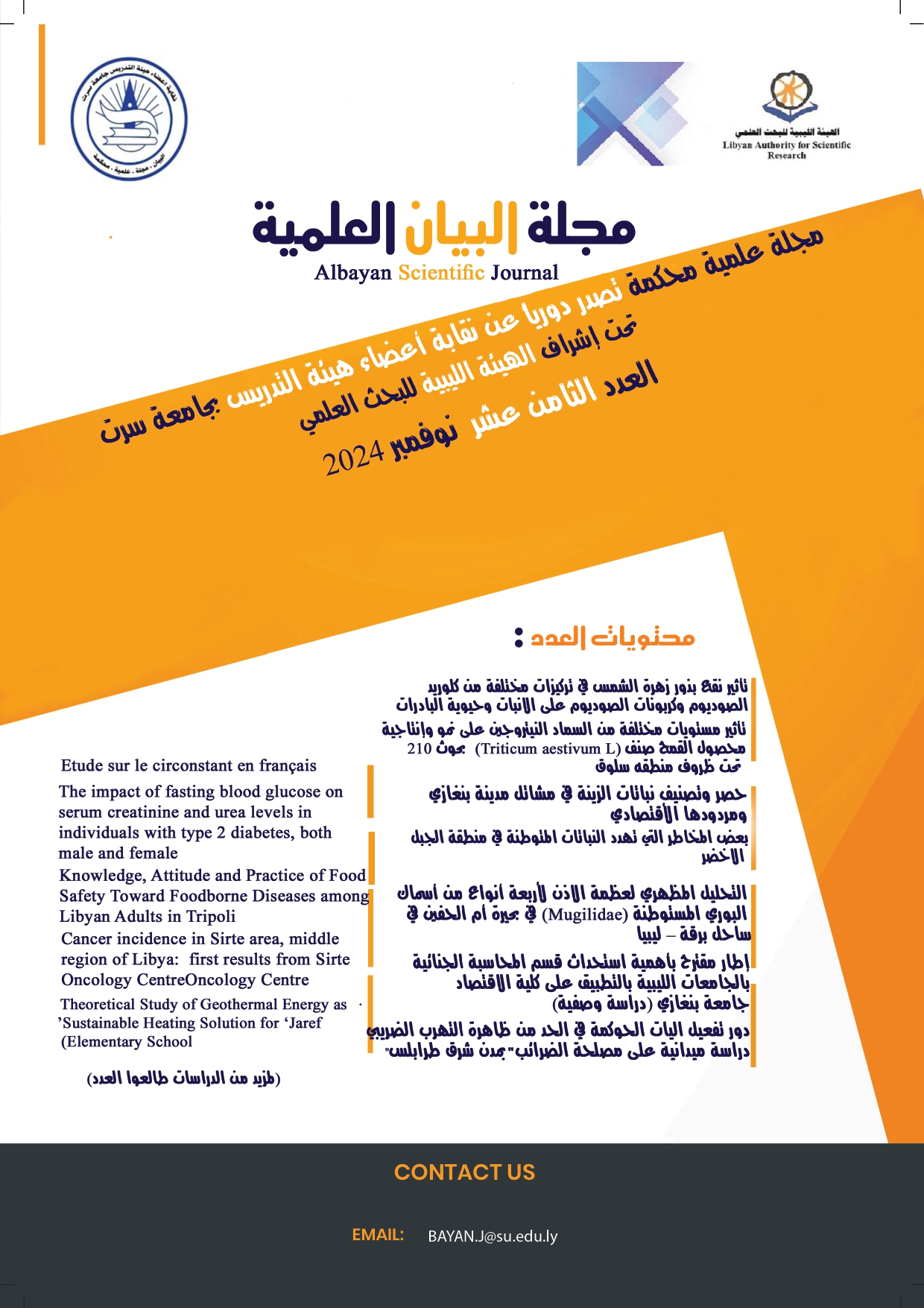تأثير مستويات الري وسماد الدواجن على إنتاجية وجودة الشعير
DOI:
https://doi.org/10.37375/bsj.vi18.3013الكلمات المفتاحية:
الشعير، معدلات الري، سماد الدواجن، المحصول ومكونات المحصول، المحتوى الكيماويالملخص
أجريت التجربة الحقلية بمشتل زهور المدينة بمدنية طبرق خلال الموسم الشتوي 2023-2024 لدراسة تأثير مستويات الري والتسميد بسماد الدواجن على المحصول وجودة الشعير صنف جيزة 123 حسب تصميم القطع المنشقة مرة واحدة مع ثلاث مكررات الصفات المدروسة هي (ارتفاع النبات، طول السنبلة، عدد السنابل/م2، وزن ألف حبة (جم)، محصول الحبوب (طن/ هكتار)، محصول القش (طن/ هكتار)، المحصول البيولوجي (طن/ هكتار)، دليل الحصاد (%)، المحتوى الكيماوي للحبوب من عناصر النيتروجين والفوسفور والبوتاسيوم. أظهرت النتائج أن زيادة مستويات الري بمعدل 100% أدت إلى زيادة معنوية في جميع صفات (ارتفاع النبات، طول السنبلة، عدد السنابل/م2، وزن ألف حبة، محصول الحبوب، محصول القش، المحصول البيولوجي، دليل الحصاد)، مقارنة بمعدل 50% الذي سجل أقل القيم في جميع صفات المحصول ومكوناته. من ناحية أخرى، سجل مستوى الري بمعدل 100% أعلى محتوي للبذور من النيتروجين والفوسفور والبوتاسيوم مقارنة بمعدل 50% الذي سجل أقل القيم من محتوي النيتروجين والفوسفور والبوتاسيوم. أظهرت النتائج أيضاً أن مستويات التسميد بسماد الدواجن بمعدل 10 طن/هكتار سجلت أعلى القيم لصفات المحصول ومكوناته (ارتفاع النبات، طول السنبلة، عدد السنابل/م2، وزن الف حبة (جم)، محصول الحبوب (طن/ هكتار)، محصول القش (طن/ هكتار)، المحصول البيولوجي (طن/ هكتار)، دليل الحصاد (%)، مقارنة بمعاملة الكنترول التي سجلت اقل القيم لهذه الصفات، كذلك سجل مستوى التسميد بسماد الدواجن بمعدل 10 طن/ هكتار على محتوي البذور من النيتروجين والفوسفور والبوتاسيوم مقارنة بمعاملة الكنترول التي سجلت اقل القيم من النيتروجين والفوسفور والبوتاسيوم. كان التفاعل بين معدلات الري ومستويات التسميد بسماد الدواجن غير معنوي على جميع صفات النمو الخضري والمحصول ومكونات المحصول والمحتوى الكيماوي التي تمت دراستها في هذه الدراسة.
المراجع
Abbas, G., Khattak, J. Z. K., Ishaque, A. M., Hussain, M., Wahedi, H. M., Ahmed, M. S. & Ullah, A. (2012). Effect of organic manures with recommended dose of NPK on the performance of wheat (Triticum aestivum L.). J. Anim. Plant Sci., 22(3): 683-687.
Abd El-Aziz, M. A. (2013). Effect of organic amendments application on some soil characteristics and yield response of wheat and soybean. J. Soil Sci. Agric. Eng., Mansoura Univ., 4 (7): 637–645.
Abdalhi, M.A., Jia, Z., Luo, W., Ali, O.O. & Chen, C. (2020). Simulation of canopy cover, soil water content and yield using FAO-AquaCrop model under deficit irrigation strategies. Russian Agric. Sci., 46: 279–288.
Abdoun, R. M., Darwish, O. S., Hashem, F. A. & Shehata, S. A. (2023). Influence of irrigation levels on morphological attributes and yield of tomato under current and climate change conditions. J. Ecol. Eng., 24(12): 1–15.
Adeleye, E. O., Ayeni, L. S. & Ojeniyi, S. O. (2010). Effect of poultry manure on soil physicochemical properties, leaf nutrient contents and yield of yam (Dioscorea rotundata) on Alfisol in Southwestern Nigeria. J. Amer. Sci., 6(10): 871-878.
Alkhalidi, A., Assaf, M.N., Alkaylani, H., Halaweh, G. & Salcedo, F.P. (2023). Integrated innovative technique to assess and priorities risks associated with drought: Impacts, Measures/ Strategies, and Actions, Global Study. Int. J. Disaster Risk Reduct., 94: 103800.
Al-Menaie, H., Ragam1, O., Al-Shatti, A., Al-Hadidi1, M. A. & Babu, A. M. (2024). Effect of tillage and mulching on growth and yield performance of barley under different nitrogen and irrigation application rates. Ind. J. Animal Res.,1-8
Arebu, H.Y. (2022). Influence of organic fertilizers on productivity of barley: A Review. Agric. Sci. Digest., 42(2): 121-127.
Averbeke, W. V.A.N. & Marais, J.N. (1992). Maize response to plant population and soil water supply. I. Yield of grain and total above ground biomass. South Afri. J. Plant Soil, 9(4): 186-192.
Bhaskaran, U. P. & Krishna, D. (2009). Effect of organic farming on soil fertility, yield and quality of crops in the tropics. UC Davis: The proceedings of the international plant nutrition colloquium XVI. Retrieved from: http://escholarship. org/uc/item/7k12w04m.
Boantă E.A., Muntean, L., Russu, F., Ona, D., Porumb, I. & Filip, E. (2019). Barley (Hordeum vulgare L.): Medicinal and Therapeutic Uses-Review. Hop and Med. Plants, 27(1-2):87-95.
Brar, B. S., Singh, J., Singh, G. & Kaur, G. (2015). Effects of long term application of inorganic and organic fertilizers on soil organic carbon and physical properties in maize–wheat rotation. Agron., 5: 220-238.
Buckman, H.O. & Brady, N.C. (1980). The nature and properties of soil, 8th ed., eurasia publishing house (P) Ltd., New Delhi, 137-16.
Chagas, V.B., Chaffe, P.L. & Blöschl, G. (2022). Climate and land management accelerate the brazilian water cycle. Nat. Commun., 13: 5136.
Chastain, J.P., Camberato, J.J. & Albrecht, J.E. (2001). Nutrient content of livestock and poultry manure. Climate Change Central, Clemson Univ., USA. 36p.
Dadhich, S. K., Somani, L. L. & Shilpkar, D. (2011). Effect of integrated use of fertilizer P, FYM and bio-fertilizers on soil properties and productivity of soybean-wheat crop sequence. J. Adv. Dev. Res., 2 (1): 42-46.
Dehghanisanij, H., Emami, S., Achite, M., Linh, N. T. T. & Pham, Q. B. (2021). Estimating yield and water productivity of tomato using a novel hybrid approach. Water, 13(24): 3615.
Dikinya, O. & Mufwanzala, N. (2010). Chicken manure-enhanced soil fertility and productivity: Effects of application rates. J. of Soil Sci. and Environ. Manag.,1(3): 46-54.
Ding, Z., Ali, E.F., Elmahdy, A.M., Ragab, K.E., Seleiman, M.F. & Kheir, A.M. (2021). Modeling the combined impacts of deficit irrigation, rising temperature and compost application on wheat yield and water productivity. Agricultural Water Management, 244, 106626.
Dube, K., Nhamo, G. & Chikodzi, D. (2022). Climate change-induced droughts and tourism: impacts and responses of Western Cape Province, South Africa. J. Outdoor Recreat. Tour., 39: 100319.
Beadle, C.L. (1993). Growth analysis. In: Photosynthesis and production in a changing environment. A field and laboratory manual; Hall DC, Scurlock JMO, Bolhar- Nordenkampf HR, Leegod RC, Long SP (eds.). pp 36-46. Chapman & Hall, London.
Eissa, M.A., Rekaby, S.A., Hegab, S.A. & Ragheb, H.M. (2018). Effect of deficit irrigation on drip-irrigated wheat grown in semi-arid conditions of Upper Egypt. J. Plant Nutri., 41(12): 1576–1586.
Farhad, W., Saleem, M. F., Cheema, M. A. & Hammad, H. M. (2009). Effect of chicken manure levels on the productivity of spring maize (Zea mays L.). The J. Anim. Plant Sci., 19(3):122-125.
Fatemi, F., Kianersi, F., Pour-Aboughadareh, A., Poczai, P. & Jadidi, O. (2022). Overview of identified genomic regions associated with various agronomic and physiological traits in barley under abiotic Stresses. Appl. Sci., 12: 5189.
Fróna, D., Szenderák, J. & Harangi-Rákos, M. (2019). The Challenge of Feeding the World. Sustainability, 11: 5816. https://doi.org/10.3390/su11205816
Guo, R., Hao, W.P., Gong, D.Z., Zhong, X.L. & Gu, F.X. (2013). Effects of water stress on germination and growth of wheat, photosynthetic efficiency and accumulation of metabolites. In: Soriano, M. H. (ed). Soil processes and current trends in quality assessment, Chapter 13, In Tech., Rijeka, Croatia.
Hamamoto, T. (2020). Effect of organic amendment on soil carbon dynamics in agricultural ecosystems. Sapporo, Japan: Hokkaido Univ., (157 p.).
Jose, A. F. & Paterniani, R. S. (2002). Differential vegetative and reproductive performances among fifteen guinea grass hybrids. Pesq agropec bras Brasília, 37(2): 139-143.
Khapte, P. S., Kumar, P., Burman, U. & Kumar, P. (2019). Deficit irrigation in tomato: Agronomical and physio-biochemical implications. Scientia horticulturae, 248: 256–264.
Kumar, A., Singh, V., Choudhary, A. K. & Singh, A. (2022). Influence of zinc and boron application on yield, quality, and nutrient uptake of barley (Hordeum vulgare L.) under rainfed conditions. Int. J. Curr. Microb. Appli. Sci., 11 (3):1272-1279.
Kumawat, P.D. (2003). Response of Barley to Organic Manure and Nitrogen Fertilization. Ph.D. Thesis, Rajasthan Agric. Univ., Bikaner, India.
Labedzki, L. & Bak, B. (2014).Meteorological and agricultural drought indices used in drought monitoring in Poland: A review. Meteorol. Hydrol. Water Manag., 2, 3–14.
Malhi, G.S., Kaur, M. & Kaushik, P. (2021). Impact of climate change on agriculture and its mitigation strategies: A review. Sustainability, 13(3): 1318.
Maqbool, M. M., Ali, A., Haq, T., Majeed, M.N. & Lee, D.J. (2015). Response of spring wheat (Triticum aestivum L.) to induced water stress at critical growth stages. Sarhad J. Agric., 31(1): 53-58.
Martínez-Fernández, J., González-Zamora, A., Sánchez, N. & Gumuzzio, A. (2015). A soil water based index as a suitable agricultural drought indicator. J. Hydrol., 522: 265–273.
Morsy, N. M. (2019). Reducing water requirement for tomato crop in late summer through field shading. Middle East J. Agric. Res., 8(3): 808–819.
Mukherjee, A., Gaurav, A.K., Patel, A.K., Singh, S., Chouhan, G.K., Lepcha, A. & Verma, J.P. (2021). Unlocking the potential plant growth-promoting properties of chickpea (Cicer arietinum L.) seed endophytes bio‐inoculants for improving soil health and crop production. Land Degrad Dev., 32(15): 4362–4374.
Mukherjee, A., Singh, S., Gaurav, A.K., Chouhan, G.K., Jaiswal, D.K., Pereira, A.P. A., Passari, A.K., Abdel-Azeem, A.M. & Verma, J. P. (2022). Harnessing of phytomicrobiome for developing potential biostimulant consortium for enhancing the productivity of chickpea and soil health under sustainable agriculture. Sci. Total Environ., 836: 155550.
Patanè, C., Tringali, S. & Sortino, O. (2011). Effects of deficit irrigation on biomass, yield, water productivity and fruit quality of processing tomato under semi-arid Mediterranean climate conditions. Scientia Horti., 129(4): 590–596.
Pecio, A. & Wach, D. (2015). Grain yield and yield components of spring barley genotypes as the indicators of their tolerance to temporal drought stress. Polish J. Agron. 21:19-27.
Qadir, M., Sharma, B.R., Bruggeman, A., ChoukrAllah, R. & Karajeh, F. (2007). Non-conventional water resources and opportunities for water augmentation to achieve food security in water scarce countries. Agric. Water Manag., 87(1): 2–22.
Ram, M., Davari, M.R. & Sharma, S.N. (2014). Direct, residual and cumulative effects of organic manures and biofertilizers on yields, NPK uptake, grain quality and economics of wheat (Triticum aestivum L.) under organic farming of rice-wheat cropping system. J. Org. Syst., 9:16–30
Rana, B., Parihar, C.M., Nayak, H.S., Patra, K., Singh, V.K., Singh, D.K. & Jat, M.L. (2022). Water budgeting in conservation agriculture-based sub-surface drip irrigation using HYDRUS-2D in rice under annual rotation with wheat in Western Indo-Gangetic Plains. Field Crops Research, 282, 108519
Rasul, G. A. M., Ahmed, S. T. & Ahmed, M. Q. (2015). Influence of different organic fertilizers on growth and yield of wheat. Am-Euras. J. Agric. & Environ. Sci., 15 (6), 1123-1126.
Samarah, N.H. (2005). Effects of drought stress on growth and yield of barley. Agron. for Sustainable Develop. 25(1): 145-149.
Sarwar, G., Schmeisky, H., Tahir, M. A., Iftikhar, Y. & Sabah, N. U. (2010). Application of green compost for improvement in soil chemical properties and fertility status. J. Anim. & Plant Sci., 20: 258-260.
Sengar, S.S., Wade, L.J., Baghel, S.S., Singh, R.K. & Singh, G. (2000). Effect of nutrient management on rice in rain fed low land of Southeast Madhya Pradesh” Indian J. Agron., 45 (2): 315-322.
Sharma, N., Singh, R.P., Sharma, V., Singh, V. & Kumar, R. (2021). Effect of nitrogen and phosphorus management on yield, nutrient content, and uptake of barley (Hordeum vulgare, L.) in Indian semi-arid region. Ind. J. Agron., 66(1): 155-161.
Shrief, A. & Abd El-Mohsen, A. (2015). Regression models to describe the influence of different irrigation regimes on grain yield and water use efficiency in bread wheat. Adv.Agric. Biol., 4 (1): 39-49.
Singh, S.K. & Singh, K.P. (2003). Effect of long term use of fertilizers, lime and FYM on yield and nutrient uptake by wheat and soil properties. J. Res., 15: 85–87
Singh, V., Singh, S.P., Singh, S. & Shivay, Y.S. (2013) Growth, yield and nutrient uptake by wheat (Triticum aestivum) as affected by biofertilizers, FYM and nitrogen. Indian J. Agric. Sci., 83, 331–334.
Spinoni, J., Vogt, J.V., Naumann, G., Barbosa, P. & Dosio, A. (2018). Will drought events become more frequent and severe in Europe? Int. J. Climatol., 38: 1718–1736.
Srivastav, A.L., Dhyani, R., Ranjan, Madhav, M. S. & Sillanpää, M. (2021). Climate-resilient strategies for sustainable management of water resources and agriculture. Environ. Sci. Poll. Res., 28(31): 41576–41595.
Tavakoli, A.R. & Moghadam, M.M. (2012). Optimization of deficit irrigation and nitrogen rates on bread irrigated wheat at northwest of Iran. Int. J. Agri. Crop Sci., 4.
Vicente-Serrano, S.M., McVicar, T.R., Miralles, D.G., Yang, Y. & Tomas-Burguera, M. (2020). Unraveling the influence of atmospheric evaporative demand on drought and its response to climate change. WIREs Clim. Chang., 11: 632.
Wu, Y., Si, W., Yan, S., Wu, L., Zhao, W., Zhang, J. & Fan, J. (2023). Water consumption, soil nitratenitrogen residue and fruit yield of drip-irrigated greenhouse tomato under various irrigation levels and fertilization practices. Agric. Water Manag., 277: 108092.
Xiaojun, S., Wang G. & Zeleke, K. T. (2020). Crop Water Production Functions for Winter Wheat with Drip Fertigation in the North China Plain. School of Agricultural and Wine Sciences, Charles Sturt University, Wagga Wagga, NSW 2650, Australia.














